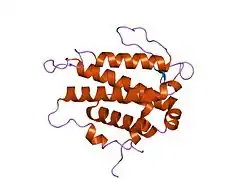MOBKL1A
Mps one binder kinase activator-like 1A, also known as Mob1 homolog 1A, is a protein that in humans is encoded by the MOBKL1A gene.[5][6]
| MOB1B | |||||||||||||||||||||||||||||||||||||||||||||||||||
|---|---|---|---|---|---|---|---|---|---|---|---|---|---|---|---|---|---|---|---|---|---|---|---|---|---|---|---|---|---|---|---|---|---|---|---|---|---|---|---|---|---|---|---|---|---|---|---|---|---|---|---|
 | |||||||||||||||||||||||||||||||||||||||||||||||||||
| Identifiers | |||||||||||||||||||||||||||||||||||||||||||||||||||
| Aliases | MOB1B, MATS2, MOB4A, MOBKL1A, MOB kinase activator 1B | ||||||||||||||||||||||||||||||||||||||||||||||||||
| External IDs | OMIM: 609282 MGI: 1915723 HomoloGene: 61676 GeneCards: MOB1B | ||||||||||||||||||||||||||||||||||||||||||||||||||
| |||||||||||||||||||||||||||||||||||||||||||||||||||
| |||||||||||||||||||||||||||||||||||||||||||||||||||
| |||||||||||||||||||||||||||||||||||||||||||||||||||
| |||||||||||||||||||||||||||||||||||||||||||||||||||
| |||||||||||||||||||||||||||||||||||||||||||||||||||
| Wikidata | |||||||||||||||||||||||||||||||||||||||||||||||||||
| |||||||||||||||||||||||||||||||||||||||||||||||||||
Function
The protein encoded by this gene is similar to the yeast Mob1 protein. Yeast Mob1 binds Mps1p, a protein kinase essential for spindle pole body duplication and mitotic checkpoint regulation.[5]
See also
References
- GRCh38: Ensembl release 89: ENSG00000173542 - Ensembl, May 2017
- GRCm38: Ensembl release 89: ENSMUSG00000006262 - Ensembl, May 2017
- "Human PubMed Reference:". National Center for Biotechnology Information, U.S. National Library of Medicine.
- "Mouse PubMed Reference:". National Center for Biotechnology Information, U.S. National Library of Medicine.
- "Entrez Gene: MOB1".
- Devroe E, Erdjument-Bromage H, Tempst P, Silver PA (June 2004). "Human Mob proteins regulate the NDR1 and NDR2 serine-threonine kinases". J. Biol. Chem. 279 (23): 24444–51. doi:10.1074/jbc.M401999200. PMID 15067004.
Further reading
- Gerhard DS, Wagner L, Feingold EA, et al. (2004). "The status, quality, and expansion of the NIH full-length cDNA project: the Mammalian Gene Collection (MGC)". Genome Res. 14 (10B): 2121–7. doi:10.1101/gr.2596504. PMC 528928. PMID 15489334.
- Ota T, Suzuki Y, Nishikawa T, et al. (2004). "Complete sequencing and characterization of 21,243 full-length human cDNAs". Nat. Genet. 36 (1): 40–5. doi:10.1038/ng1285. PMID 14702039.
- Bonaldo MF, Lennon G, Soares MB (1996). "Normalization and subtraction: two approaches to facilitate gene discovery". Genome Res. 6 (9): 791–806. doi:10.1101/gr.6.9.791. PMID 8889548.
- Bichsel SJ, Tamaskovic R, Stegert MR, Hemmings BA (2004). "Mechanism of activation of NDR (nuclear Dbf2-related) protein kinase by the hMOB1 protein". J. Biol. Chem. 279 (34): 35228–35. doi:10.1074/jbc.M404542200. PMID 15197186.
- Strausberg RL, Feingold EA, Grouse LH, et al. (2002). "Generation and initial analysis of more than 15,000 full-length human and mouse cDNA sequences". Proc. Natl. Acad. Sci. U.S.A. 99 (26): 16899–903. Bibcode:2002PNAS...9916899M. doi:10.1073/pnas.242603899. PMC 139241. PMID 12477932.
- Chow A, Hao Y, Yang X (2010). "Molecular characterization of human homologs of yeast MOB1". Int. J. Cancer. 126 (9): 2079–89. doi:10.1002/ijc.24878. PMID 19739119. S2CID 33688672.
This article incorporates text from the United States National Library of Medicine, which is in the public domain.
This article is issued from Wikipedia. The text is licensed under Creative Commons - Attribution - Sharealike. Additional terms may apply for the media files.




